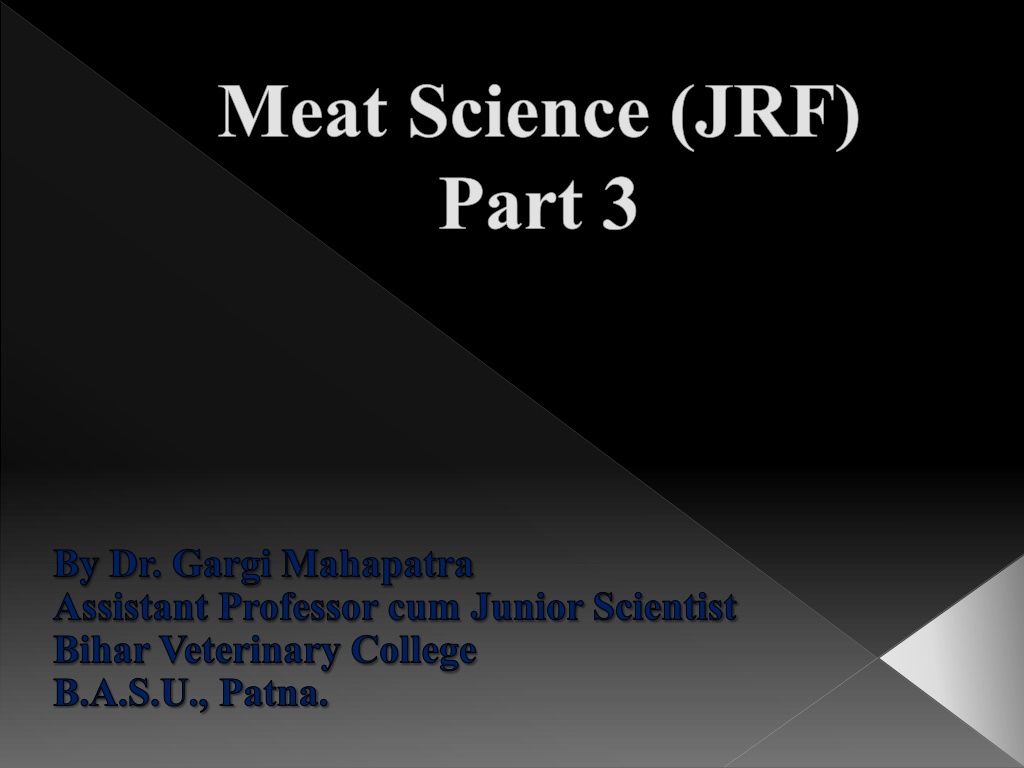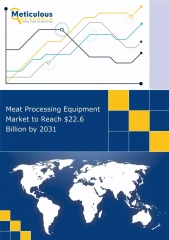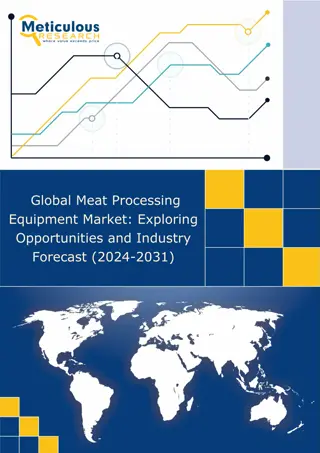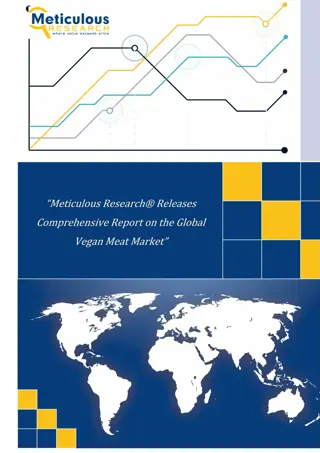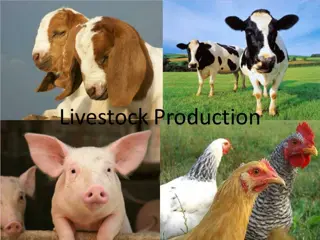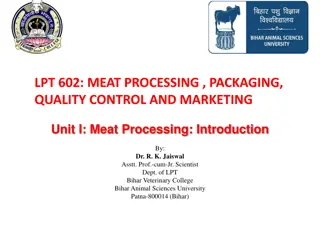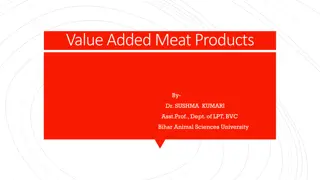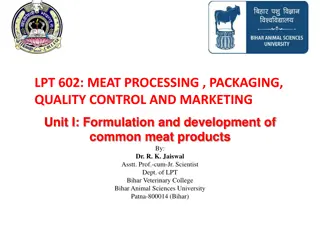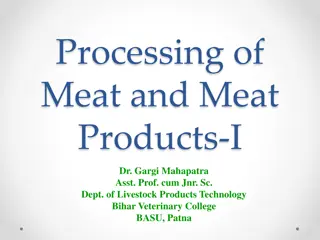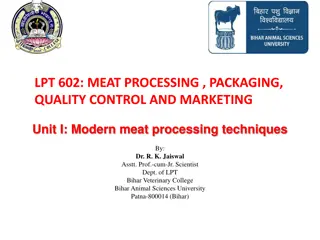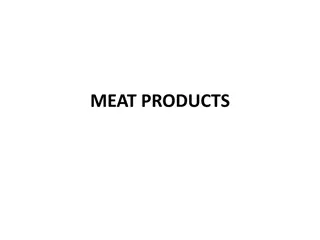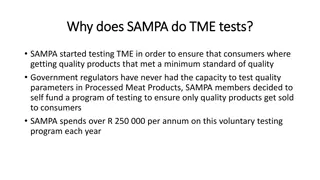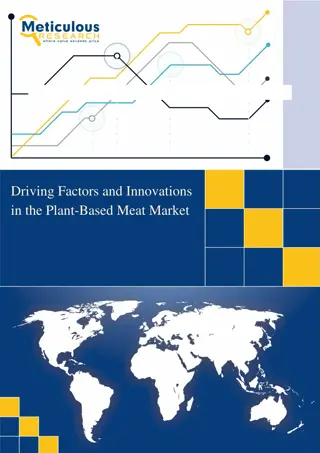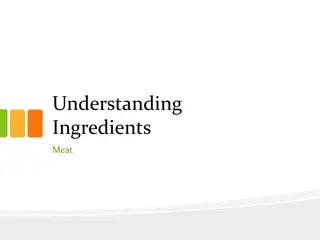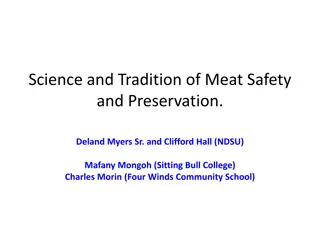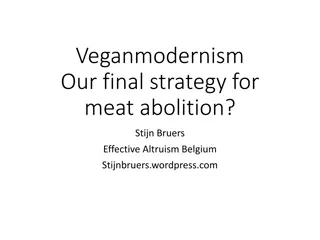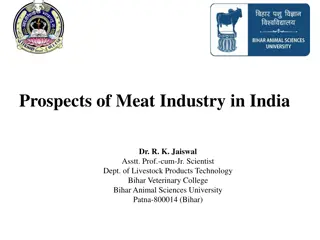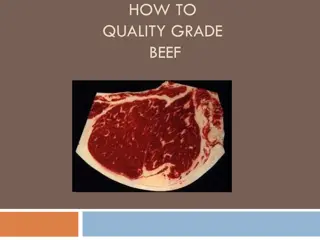Understanding Animal By-products in Meat Science Research
This article delves into the realm of animal by-products in meat science, exploring their categorization and diverse uses in various industries such as food, pharmaceuticals, and cosmetics. From secondary products like Hoof/Feet and horns, thyroid glands, to bones, this comprehensive guide sheds light on the value and applications of these often-overlooked components.
Download Presentation

Please find below an Image/Link to download the presentation.
The content on the website is provided AS IS for your information and personal use only. It may not be sold, licensed, or shared on other websites without obtaining consent from the author. Download presentation by click this link. If you encounter any issues during the download, it is possible that the publisher has removed the file from their server.
E N D
Presentation Transcript
Meat Science (JRF) Part 3 By Dr. Gargi Mahapatra Assistant Professor cum Junior Scientist Bihar Veterinary College B.A.S.U., Patna.
Animal By-products A secondary product derived during the manufacturing or processing of the main product. (30-35% value) Based upon utility by Raw material -products are categorized to edible, inedible and borderline Primary by- Product products. In some cases the edible products byproducts are a.k.a variety meats. Utilization Secondary All organs segregated, processed & chilled By-prod under sanitary conditions ex. liver, kidney heart, ox-tail, tripe, chitterlings, fries etc.
Secondary Primary Hoof/Feet and horns ANIMAL BY-PRODUCTS-I Neats Foot Oil, button, combs, hoof /horn meal, fertilizers, gelatin, glue etc. Lanolin, fertilizers, brushes, carpets, fabrics, pillows etc. Blood meal/pudding/sausage, Hb, serum, plasma, albumin, fibrin etc. Bone meal, glue, min. suppl. etc. Bile salts, Gall stones. Heparin, Peptone. Melatonin Hormone Hair/ Bristles and wool Blood Bones Gall Bladder Lung Pineal Gland Pituitary Anterior Poserior GH,LH,FSH and Prolactin Oxytocin and Vasopressin
Secondary Primary Thyroid Gland Stomach Liver Pancreas ANIMAL BY-PRODUCTS-II Thyroxine Pepsin, Renin, Heparin, Rennet Liver extract Insulin, Glucagon, Sweet bread(Gut), Bates (Batting of leather), Trypsin, Pancreatin. Testosterone and Hyaluronidase. Casings, catgut, caul fat etc. Tallow for soap, machine oil, meat/bone meal, leather dressing etc. Compost, manure, methane as fuel for light, heat and power, recycling as stock feed etc. Leather, gelatin, glue, fertilizer etc. Testes Intestine Condemned meat Ruminal and intestinal contents/ ingesta Skin/ Hide
Fallen/ Dead Animals Carcass Hides/ Skin Slaughtered Animals Carcass Meal Leather and leather Meat Meal articles Leaf Fat- Kidney Fat Technical Fat Tallow Beef/ Mutton Fat Bone Meal Caul Fat- Intestine/ Mesentery Fat Suet- Hard fat ass. with loin and kidney Smaltz-Chicken or goose subcutaneous fat Sweet breads- Gut sweet bread (Pancreas) and Neck sweet bread (Thymus) & Melts- Spleen
Bones 15% of Dressed carcass 12-30% of live wt. (C/B/P) 20-30% of live wt. (S/G) Green/ Fresh Bones 50% Moisture 23% Inorganic Matter 12% Organic Matter 1:2 15% Red and Yellow Marrow 96% of Red and yellow Marrow is Fat Organic Matter of Bone: Ossein Inorganic Matter of Bone: 33% Ca, 15% P, Na, K, Mg, Cu, Zn, Fe, Co, Mn Bone by-product: Gelatin, Glue, Bone meal, Fertilizer
Utilization of Bones Bones are utilized to render fat, produce gelatin/glue and mineral concentrates like osteo-calcium tablets or bone meal Rendering Dry Rendering Wet Rendering Bone Digester Steam not in contact Steam in contact Steam in contact 75psi X 3-4 hrs. 40psi X 4-8 hrs. 60psi X 2 hrs. End Product called End product called Craclkling,fat removed slush, sent to digester meal,32.5% Ca+15% P by centrifugation to there is better recovery Fat & gelatin recoverd 30 mins, <5% of fat End product is bone
Yield and Conversion Ratio 15% (Horn + Hoof+ Ruminal & Intestinal content) 7% Hide / 11% Skin Carcass 2/3rdMoisture (drying) 1/3rdMeat Meal and Bone Meal
BONE MEAL AND BLOOD MEAL Composition Average conversion ratio of raw material to dry meal by: Dry rendering 3:1 Wet rendering 4:1 Meat meal Carcass Meal (Dry) (Bone + Meat Meal) Protein >55% Protein <55% P+Min. - 85% Phosphorous >4.5% Moisture-7% Moisture- 3-5% Crude Fat- 8% Phosphorous-4.5% Conversion of raw blood to blood meal- 5:1 Bone Meal Blood Meal (Steamed) Protein- 7% Protein- >80% Calcium 32.5% Calcium- Low Phosphorous- 15% Phosph- Low Moisture- 7% Moisture- 10-12%
Gelatin/Glue Both chemically same Gelatin-Amorphous & Transparent, absorbs water 5-10 times its weight and dissolves on warming up to 30 C. Edible used as emulsifier and binder. Glue is dark colured and low quality gelatin. Obtained from 6 long bones- Femur, Tibia, Radius, Ulna, Humerus and Metatrsus. Bones Rendered Demineralized (4-10% HCl, 1-2 days) Vacuum Evaporation 60 C Highest quality Gelatin Concentration (30-40%) 65-70 C Medium quality Gelatin and 80 C Low/Poor quality Gelatin Drying (8-12% moisture) 100 C Glue Cooked in water bath For 3-5 hrs
Neats Foot Oil Horn Obtained from shin bones separated from the hoof Scalding Pale yellow liquid used as lubricant in aeropl (60 C) -anes and delicate machinery. Does not freeze or dry at extreme low temp. Pith Proper Yield per animal few ml. Gelatin Articles Horn Meal Fertilizers Bone Meal Hoof Meal
Serum Yield Blood Yield UTILIZATION OF BLOOD 10-12% of blood collected No anti-coagulant used Centrifuge 1000 rpm Filtered (Seitz Filter) Shelf life: 1 month (4-5 C) or 6 months (-20 C) 0.05% phenol on wt. basis yields clear yellow serum 5-7% of live wt. C&B- 10-12kg Pig- 2-3g S&G- 1-1.5kg Poultry- 30-50 gm Stored in vessels 15 cm depth and 45 cm dia., sterilized by steam or hypochlorite sol. Albumen Yield Dried blood serum referred as albumen 10-20% the weight of serum Spray or vacuum dried into fine powder Shelf-life- Few months, air tight cond. when stored in cool places.
Important Points Blood Anticoagulant Plasma Fibrin Fibrin Foam- Soaks liquid 30 times its wt. - Used in surgeries (nerve, arterial & prostate) - Contains < 2% Fibrinogen - pH 6.25 - Does not inhibit action of antibiotics - Digested by body system Fibrin powder-Arrests bleeding in skin injuries where coagulation is delayed.
Processing of Blood Meal- Part 1 Blood Collection (15 cm deep X 45 cm dia.) Storage and Transport (whole blood mixed with equal amount of rice-bran / 1% of quick lime /common salt @ 20%) Heat Treatment or Cooking (100 C x 30 min) Pressing (blood collected in Hessain bag / Porous bag, hung and squeezed, remove 40-45% moisture) Drying
Processing of Blood Meal- Part 2 Drying (Sun Drying or Cabinet Drying) Cooling and Milling Fumigation(Preservation) (Blood meal disinfected with methyl btomide, ethyl oxide etc.) Packaging (polyethylene bags or air tight containers) *blood meal- brown granular product rich in essential amino acid, lysine 6-9%
Utilization of Intestines Used for manufacturing of natural casings Casings prepared from sub-mucosa (rich in collagen) Fresh intestines are known as Green intestines which if not processed are stored at chilled at 10 C Casings are used to manufacture sausages, which vary based upon processing techniques Fresh Sausage- Fresh Salami Cooked Sausage- Liver Sausage, Braunschweiger, Cooked Salami Uncooked Smoked Sausage- Metwurst, Italian Pork Sausage Cooked Smoked Sausage- Frankfurter, Bologna, Knackwurst, Berliner Dry Fermented- Peperoni, Thuringer, Dry Salami, Summer Sausage, Cappicola, Cervelat Emulsified Sausage- Frankfurters, Bologna, Salami Dry Sausage- Mortadella Spicy Sausage- Weasand, Hot Dog
Maws: Stomach of Pig Rounds: Small Intestine of S/G/P Middles: Large Intestine of C&B Runners: Small Intestine of C&B Chitterlings: Large Intestine of Pig Bung: Caecum of C&B Mortadella: Urinary Bladder of large animal Waesund: Oesophagus of large animal Natural Types of Casings Cellulose: Prepared from cotton linters Inedible Collagen: Disposed Carcasses Edible Collagen: Slaughtered (healthy) animals Plastics Artificial
Manufacturing of Natural Casings Careful removal of Intestinal Tract Pulling (Mesentry and Fat removed) Chilling (Practiced in green casings) Stripping Flushing Fatting
Contd.. Fermentation (S/G/P intestine in salted or unsalted water at 20 C for 1-2 days) Turning (For C & B intestine only, for efficient sliming) Sliming (Casings dipped in sol consisting of 0.2% sodium pyrophosphate and 1% NaCl for 10-15 min. then scrapped with a wooden knife at 30 angle ) Measuring, Inspection and Grading Preservation Packaging (Metal tins covered with food grade polyethylene lining)
Terminologies of Casing Defects Cicatrices: Scars from healed intestinal wounds Domestics: Small grease spots on casings Kink: Twisted loop on casings Rust: Black Spots due to putrefaction
Measurement of Casings Casings are measured in Hanks Casings Salted Casings (S&G) Dried Casings (C&B) Rounds: 92 m= 1 Hank Runners Middles 180 m= 1 Hank 90 m= 1 Hank
Thank you
